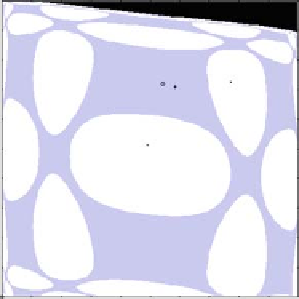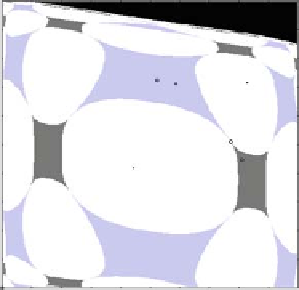Chemistry Reference
In-Depth Information
1
x
2
x
2
c
2
E
S
NE
E
S
c
2
NE
c
1
E
2
E
1
c
1
x
1
x
1
0
1
0
1
(a)
(b)
Fig. 5.2
The duopoly game with logistic reaction functions. Firm 2 has full information but firm
1 has misspecified demand. (
a
) The misspecification parameter of firm 1 is "
1
D
1:12, E
S
is
the unique stable steady state (
light grey
basin of attraction) coexisting with a stable cycle of
period 2 (
white basin
). Other parameters are
1
D
2:8;
2
D
2:9;"
1
D
1:12;"
2
D
1.(
b
)The
misspecification parameter of firm 1 increases to "
1
D
1:18. Two new subjective equilibria E
1
;E
2
emerge, of which E
1
is stable (
dark grey
basin of attraction) and E
2
is unstable. Other parameters
are
1
D
2:8;
2
D
2:9;"
1
D
1:18;"
2
D
1
with "
1
D
1:12 and "
2
D
1. In this case the strategy space consists of the basins
of two coexisting attractors, namely the subjective equilibrium E
S
and a 2-cycle
C
2
D
.c
1
;c
2
/ (as well as a small portion of the basin of infinity). If the misspecifi-
cation parameter "
1
is further increased, two new steady states are created, denoted
by E
1
and E
2
in Fig. 5.2b (obtained for "
1
D
1:18). These new subjective equilibria
are created via a saddle-node bifurcation (through a mechanism similar to the one
shown in Fig. 5.1) and, as a result, they appear far away from E
S
. The subjective
equilibrium E
1
is stable (a stable node) and E
2
is unstable. Furthermore, a stable
cycle C
2
coexists.
Observe that the Nash equilibrium NE of the true game is located in the basin
of E
S
and is quite near to E
S
. If the initial quantities of the firms are located in
the basin of E
S
, then the adjustment process leads to a situation where the long run
outcome is close to the Nash equilibrium of the true game. On the other hand, if
the trajectories converge to E
1
, then the adjustment process based on misspecified
demand relationships leads the firms to an equilibrium which is quite different from
the true Nash equilibrium. It is interesting to notice that Fig. 5.1b shows that in
E
1
firm 1 has a higher market share, and it turns out that it also has a higher profit
than firm 2 ('
1
D
0:465;'
2
D
0:2). Despite the fact that firm 2 knows the true
demand, firm 1 (although unwittingly) achieves not only market dominance, but -
with regard to the full information case - gains a higher profit, whereas firm 2's
profit is reduced by more than 50%.


Search WWH ::

Custom Search